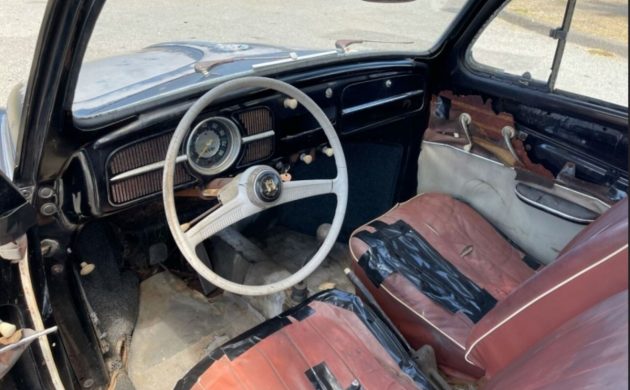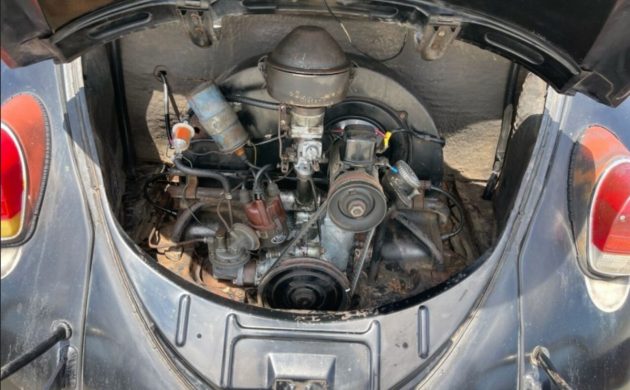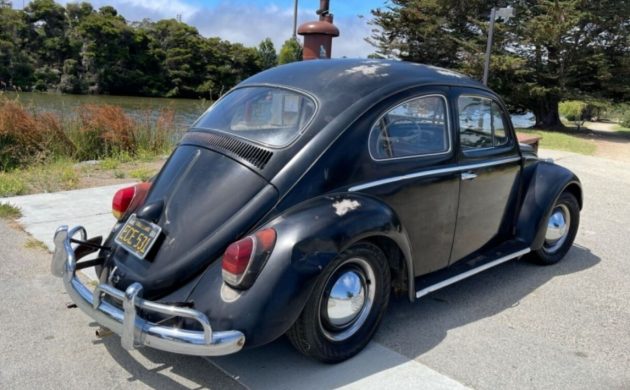The owner of this 1958 VW Beetle found the little gem hidden away in a Californian barn. It sat in that spot, largely forgotten, since 1999. He dragged the car into the light of day, and after a bit of tinkering, he has coaxed its engine back to life. The car runs and drives, but it will still require work before it could be considered roadworthy. If you feel up to the challenge of restoring one of the most instantly recognizable cars ever built, you will find the Beetle located in Pebble Beach, California, and listed for sale here on eBay. The owner has set the BIN at $8,500, but he leaves the option to make an offer.
This little Beetle is finished in Code L41 Black, although evidence suggests a previous owner might have treated it to at least a partial repaint. If the buyer wants to retain the car’s character, they could drive the Beetle as is. Alternatively, applying a clearcoat would protect the existing paint and the steel from further deterioration. The body has a few minor dings and dents, but there’s nothing present that would require a buyer to replace any exterior steel. The same is true when we reach the question of rust. The panels are clean, but there is some rust elsewhere that will demand attention. This has impacted the bottom of the spare wheel carriers, and there are some nasty spots in the floors that will need to be tackled sooner rather than later. The worst of this is on the passenger side, and the resulting hole is pretty big. I admit that I was surprised by this given the time that the car has spent in California. Maybe the vehicle spent part of its life out-of-state in a more hostile environment, and that has contributed to the rust issues. I would be inclined to perform a thorough inspection to determine whether this is the extent of the problems. The exterior trim is pretty presentable for a survivor, but I have noticed that a previous owner has installed later taillights. If this is an issue, sourcing and installing the correct units should not be complicated or expensive. If genuine parts are difficult to locate, quite a few companies can supply high-quality reproduction parts.
The Beetle’s interior is one area that will demand plenty of attention if it is to present at its best. The original Red leatherette upholstery has deteriorated beyond the point of no return, and even the tape holding large sections together shows the stress. All of the upholstery would need to be replaced if the buyer is seeking a spotless restoration. The headliner appears to be the highlight because it has avoided much of the deterioration to which they are susceptible. There are a couple of seam separations, but these look repairable. Returning the interior to its former glory should not be an expensive proposition. Kits with everything required in the correct color and grain are available for around $950, or the buyer could update to a material like a tweed cloth for $1,100. Beyond that, they would need to restore the wheel and source a radio blanking plate. Compared to other classics from this era, getting this interior up to scratch reflects the VW engineering philosophy of being affordable and user-friendly.
After more than two decades of inactivity, the owner has successfully breathed new life into this Beetle’s engine. It isn’t clear whether it’s numbers-matching, but it does feature the 1,191cc air-cooled, rear-mounted flat-four that pumped out 36hp in its prime. That power finds its way to the road via the rear wheels and a 4-speed manual transmission. The Beetle is not a high-performance car designed to set the ¼-mile alight. The original design brief stated that the vehicle should be capable of cruising on the German autobahn continuously at 60mph for four hours between stops without any issues or problems. That Volkswagen was successful in its objective in a car that was also frugal on fuel represented a design and engineering triumph for the company. While this Beetle now runs and drives, it should not be considered roadworthy. The exhaust is showing a lot of rust and holes, so replacing that will be a priority. However, that issue will play second fiddle to the brakes. Currently, the only thing that works is the e-brake. It isn’t clear what the problem is with the system, but the buyer can bank on the system needing a few hydraulic components. Beyond that, the little flat-four sounds quite sweet, and the transmission shifts smoothly.
The Volkswagen Beetle is almost certainly the first car to develop its own Hollywood movie franchise. By the time “Herbie” appeared in the 1968 movie “The Love Bug,” the Beetle was showing its age. By that point, the car may have been around for thirty years, but a new generation was turned on to the Beetle thanks to its exploits on the silver screen. They also became a favorite among the 1960s “hippie” set because they were cheap to buy and even cheaper to run. All good things must come to an end, and the days of ultra-cheap Beetles seem to be well into the past. When it was shiny and new, this car would’ve cost its original owner around $1,600 by the time he drove it out of the dealership. If this car proves to be numbers-matching and the buyer performs a meticulous restoration, there’s no reason why it couldn’t command a price beyond $50,000 in today’s market. The original Beetle concept called for it to be an affordable car for the people. They are becoming less so with each passing year, and it’s why I think that someone will snap up this one pretty quickly.







This one is offered by Dodi Auto Sales in Monterey California and their claim to fame has to be an appearance on the TV show Chasing Classic Cars. Wayne Carini stopped by and bought a car to take to the Concours d’Lemons. They always have a few interesting classics on the lot and if I’m not mistaken, Wayne has repeated the process several times.
36 did not have vacuum advance…be blessed, grateful, prepared,,,
They did have vacuum advance I have had many of them some buses have the mechanical advance
Tail lights don’t look right for this year of car.
They aren’t. I’ve owned several early VW’s and the tail lights on this one are from several years later. The appropriate ones for this year are much smaller.
I hate to beat a dead horse, but does anyone else have an issue with “logging in”? I get about 4 or 5 “early access”, then I have to log in again, and today, had trouble logging in altogether. If I comment on a early access, guaranteed have to log in again. Whassup, staff? It’s a PITA,,,
The ’58 Bug was actually a much improved Bug from previous models. I use this website for the changes,
http://www.vw-resource.com/years.html
the ’58 had bigger windshield, new instrument panel, better brakes and clutch and while it still used the 36 hp. they changed the gear ratios for 3rd and 4th. They also changed the gas pedal from that awful roller one to flat. My friend had a ’58, and it kept right up with traffic,,to a point. To be honest, a VW would run better at 60, as it ran a lot cooler being fan cooled.
Those are later model tail lights, ( ’68, I think)and a gas gauge was a few years away, and still required that fancy footwork to move the reserve lever, and then, it was very important to return it after getting gas. Adam was right in not finding performance figures on these, but I did find, a ’57 Bug would do 0-60 in the high 20’s, and a 1/4 mile in about 24 seconds, probably around 50 mph.
Everybody has a VW story, and let’s hear them.
@Howard – We haven’t received any other complaints about the login so it might be something with your setup. What operating system and browser are you using? Do you have cookies enabled? You can always email us with issues like this too. Thanks.
Thanks for checking, Jesse. Since I’m an idiot when it comes to computers, I have no idea what you are talking about, and I’ll just have to put up with it.
They are newer replacements, late 60’s-70’s era I believe
I had a 63 VW that a previous owner had installed a 64 VW Bus gear reduction transaxle in it. Top speed was about 55 mph, but it would climb ANY hill you could get it’s front tires on! I drove it for six months with nothing but an Ebrake, and downshifts. I eventually replaced the front to rear brake line and drove it for another year. It was the first of many VWs I owned in my teens and early twenties. Great memories, wish I had a few of them back!
Someone once said that if you bought every gas-saving gadget for a VW in the J.C. Whitney catalog you’d have to stop every few miles to drain the gas out…
One of my favorite J.C. Whitney VW products in 1971 was called the “Hermes Airfoil Stabilizer” designed to mount under the very front of a VW bug and make it less susceptible to crosswinds, for $19.95. It looked like it was made in 8th grade Metal Shop, offered no help whatsoever and lasted until the first snow storm of the year.
There’s a lot of rot on the pans… and the front package tray is nearly gone… the O.G. tail lights are very valuable in the VW world compared to the mis-matched units on the car now. No brakes, trashed interior…this car is way overpriced for it’s condition.
My only VW story: owned a 66 beetle for about 2 months, in January and February. On the couple of days the sun was shining it was a wonderful fun car. The rest of the time I was driving a frozen ice box and scraping the windshield from the inside of the car. My toes went numb by the end of the 1 Hour drive to work…..
I don’t know how these old beetles bring such big money! I bought one new in 1967, a 1300cc job, mainly for its legendary reliability and “go anywhere” capability. Sure it was great to drive it places where other cars feared to go. But burnt valves, cracked chassis, it was no more reliable that the 20 years older MG Y sedan that I traded on it. If I had it all over again, I would have put a little cash into the MG and not spent the bigger amount on the VW. But there’s more, they do catch fire in a night time front-ender!
For 1958 some improvements from previous years were:
Brake drums and shoes widened for faster surer stops.
Rear window and windshield enlarged.
Front turn signal lights moved to top of fender.
Radio grill moved left, in front of driver.
Accelerator pedal introduced, formerly a roller.
The Bug improvements continued each and every year they were manufactured.